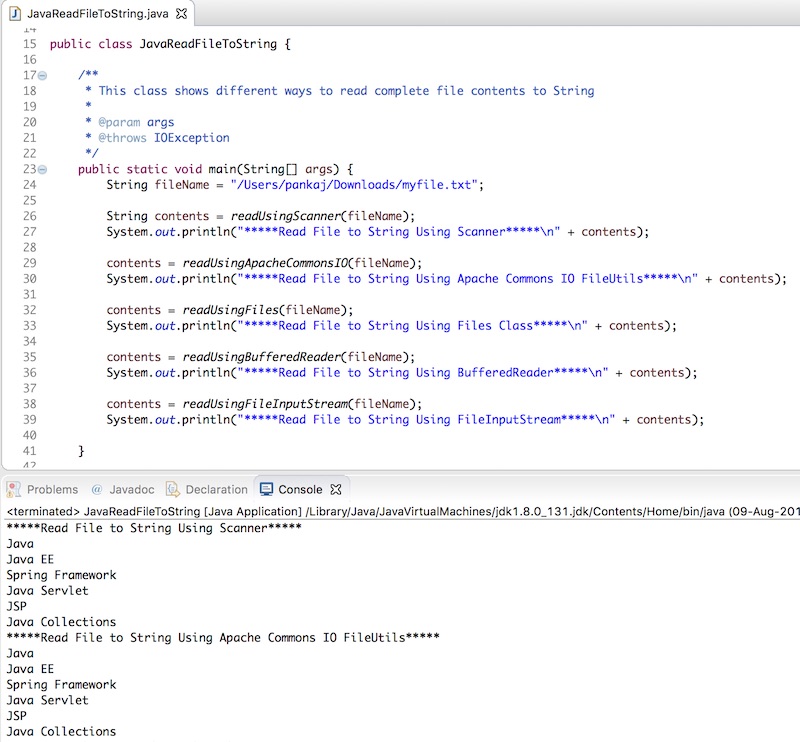有时在处理文件时,我们需要在Java中将文件读取为字符串。今天我们将研究在Java中将文件读取为字符串的各种方法。
Java读取文件为字符串
在Java中,有许多读取文件为字符串的方法。在本教程中,我们将探讨以下几种方法。
- 使用BufferedReader在Java中将文件读取为字符串
- 使用FileInputStream在Java中将文件读取为字符串
- 使用Files类在Java中将文件读取为字符串
- 使用Scanner类将文件读取为字符串
- 使用Apache Commons IO FileUtils类在Java中将文件读取为字符串
 现在让我们看看这些类,并将文件读取为字符串。
现在让我们看看这些类,并将文件读取为字符串。
使用BufferedReader在Java中将文件读取为字符串
我们可以使用 BufferedReader 的 readLine 方法逐行读取文件。我们只需要将它们追加到一个带有换行字符的 StringBuilder 对象中即可。下面是使用 BufferedReader 读取文件到字符串的代码片段。
BufferedReader reader = new BufferedReader(new FileReader(fileName));
StringBuilder stringBuilder = new StringBuilder();
String line = null;
String ls = System.getProperty("line.separator");
while ((line = reader.readLine()) != null) {
stringBuilder.append(line);
stringBuilder.append(ls);
}
// 删除最后的换行符
stringBuilder.deleteCharAt(stringBuilder.length() - 1);
reader.close();
String content = stringBuilder.toString();
还有另一种高效的方法可以使用 BufferedReader 和 字符数组 读取文件到字符串。
BufferedReader reader = new BufferedReader(new FileReader(fileName));
StringBuilder stringBuilder = new StringBuilder();
char[] buffer = new char[10];
while (reader.read(buffer) != -1) {
stringBuilder.append(new String(buffer));
buffer = new char[10];
}
reader.close();
String content = stringBuilder.toString();
使用 FileInputStream 在 Java 中将文件读取为字符串
我们可以使用 FileInputStream 和 字节数组 将文件读取为字符串。您应该使用此方法读取非基于字符的文件,例如图像、视频等。
FileInputStream fis = new FileInputStream(fileName);
byte[] buffer = new byte[10];
StringBuilder sb = new StringBuilder();
while (fis.read(buffer) != -1) {
sb.append(new String(buffer));
buffer = new byte[10];
}
fis.close();
String content = sb.toString();
使用 Files 类在 Java 中读取文件到字符串
我们可以使用 Files 实用程序类在一行代码中读取所有文件内容到字符串。
String content = new String(Files.readAllBytes(Paths.get(fileName)));
使用Scanner类将文件读取为字符串
Scanner类是在Java中将文本文件快速读取为字符串的一种方法。
Scanner scanner = new Scanner(Paths.get(fileName), StandardCharsets.UTF_8.name());
String content = scanner.useDelimiter("\\A").next();
scanner.close();
使用Apache Commons IO FileUtils类将Java文件读取为字符串
如果您的项目中使用了Apache Commons IO,则这是在Java中将文件快速读取为字符串的简单方法。
String content = FileUtils.readFileToString(new File(fileName), StandardCharsets.UTF_8);
Java文件读取为字符串示例
这是一个具有适当的异常处理和显示所有不同读取文件为字符串的方式的最终程序。
package com.journaldev.files;
import java.io.BufferedReader;
import java.io.File;
import java.io.FileInputStream;
import java.io.FileReader;
import java.io.IOException;
import java.nio.charset.StandardCharsets;
import java.nio.file.Files;
import java.nio.file.Paths;
import java.util.Scanner;
import org.apache.commons.io.FileUtils;
public class JavaReadFileToString {
/**
* This class shows different ways to read complete file contents to String
*
* @param args
* @throws IOException
*/
public static void main(String[] args) {
String fileName = "/Users/pankaj/Downloads/myfile.txt";
String contents = readUsingScanner(fileName);
System.out.println("*****Read File to String Using Scanner*****\n" + contents);
contents = readUsingApacheCommonsIO(fileName);
System.out.println("*****Read File to String Using Apache Commons IO FileUtils*****\n" + contents);
contents = readUsingFiles(fileName);
System.out.println("*****Read File to String Using Files Class*****\n" + contents);
contents = readUsingBufferedReader(fileName);
System.out.println("*****Read File to String Using BufferedReader*****\n" + contents);
contents = readUsingBufferedReaderCharArray(fileName);
System.out.println("*****Read File to String Using BufferedReader and char array*****\n" + contents);
contents = readUsingFileInputStream(fileName);
System.out.println("*****Read File to String Using FileInputStream*****\n" + contents);
}
private static String readUsingBufferedReaderCharArray(String fileName) {
BufferedReader reader = null;
StringBuilder stringBuilder = new StringBuilder();
char[] buffer = new char[10];
try {
reader = new BufferedReader(new FileReader(fileName));
while (reader.read(buffer) != -1) {
stringBuilder.append(new String(buffer));
buffer = new char[10];
}
} catch (IOException e) {
e.printStackTrace();
} finally {
if (reader != null)
try {
reader.close();
} catch (IOException e) {
e.printStackTrace();
}
}
return stringBuilder.toString();
}
private static String readUsingFileInputStream(String fileName) {
FileInputStream fis = null;
byte[] buffer = new byte[10];
StringBuilder sb = new StringBuilder();
try {
fis = new FileInputStream(fileName);
while (fis.read(buffer) != -1) {
sb.append(new String(buffer));
buffer = new byte[10];
}
fis.close();
} catch (IOException e) {
e.printStackTrace();
} finally {
if (fis != null)
try {
fis.close();
} catch (IOException e) {
e.printStackTrace();
}
}
return sb.toString();
}
private static String readUsingBufferedReader(String fileName) {
BufferedReader reader = null;
StringBuilder stringBuilder = new StringBuilder();
try {
reader = new BufferedReader(new FileReader(fileName));
String line = null;
String ls = System.getProperty("line.separator");
while ((line = reader.readLine()) != null) {
stringBuilder.append(line);
stringBuilder.append(ls);
}
// 删除最后的ls
stringBuilder.deleteCharAt(stringBuilder.length() - 1);
} catch (IOException e) {
e.printStackTrace();
} finally {
if (reader != null)
try {
reader.close();
} catch (IOException e) {
e.printStackTrace();
}
}
return stringBuilder.toString();
}
private static String readUsingFiles(String fileName) {
try {
return new String(Files.readAllBytes(Paths.get(fileName)));
} catch (IOException e) {
e.printStackTrace();
return null;
}
}
private static String readUsingApacheCommonsIO(String fileName) {
try {
return FileUtils.readFileToString(new File(fileName), StandardCharsets.UTF_8);
} catch (IOException e) {
e.printStackTrace();
return null;
}
}
private static String readUsingScanner(String fileName) {
Scanner scanner = null;
try {
scanner = new Scanner(Paths.get(fileName), StandardCharsets.UTF_8.name());
// 我们可以使用分隔符正则表达式"\\A"、"\\Z"或"\\z"
String data = scanner.useDelimiter("\\A").next();
return data;
} catch (IOException e) {
e.printStackTrace();
return null;
} finally {
if (scanner != null)
scanner.close();
}
}
}
您可以使用上述任何方式将文件内容读取为Java字符串。但是,如果文件大小很大,则不建议这样做,因为您可能会遇到内存不足错误。
你可以从我们的 GitHub 代码库 中查看更多 Java IO 示例。
参考:
Source:
https://www.digitalocean.com/community/tutorials/java-read-file-to-string













